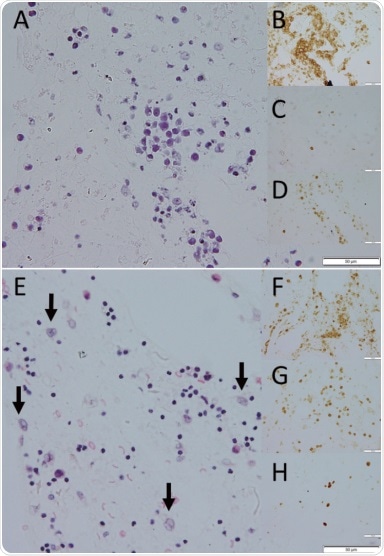
Pathological staining of vitrectomy cell blocks for two cases (top and bottom) where PIOL occurred without the development of central nervous system lymphoma.
Researchers at Okayama University report in the Journal of clinical and experimental hematopathology that primary intraocular lymphoma, a cancer in the eye, does not always develop into central nervous system lymphoma. In addition, the scientists confirmed that there is no marker available to predict when the former will develop into the latter.
Now, Professor MATSUO Toshihiko (eye doctor) and Assistant Professor TANAKA Takehiro (pathologist) from Okayama University have addressed the question whether there are PIOLs that do not develop central nervous system lymphoma. They observed a group of patients, and found that in the small number of cases, PIOL does not spread to the central nervous system. Importantly, PIOL has a good prognosis if it does not develop into central nervous system lymphoma.
The researchers studied 22 patients (14 women, 8 men) for up to 14 years. The patients’ ages ranged from 42 to 84 years at the time of the first eye examination. In 12 patients, both eyes were affected by PIOL; in the others, only one eye. All 22 patients underwent vitrectomy (surgery in which some or all of the vitreous gel between the retina and the lens in the middle of the eye is removed) after diagnosis of PIOL.
Of the 22 patients, 17 developed central nervous lymphoma. For 3 of the 5 patients who did not, the follow-up period was relatively short (up to 3 years). The follow-up periods for the other 2 patients were 5 and 11 years; these patients did not undergo chemotherapy or radiation of the eye. Based on these long-term follow-up results, Matsuo and Tanaka concluded that PIOL does not necessarily develop into central nervous system lymphoma.
The scientists also examined whether the presence of a protein called CD5 in specimens taken during vitrectomy surgery are a marker of central nervous system lymphoma. But both patients with CD5-positive and patients with CD5-negative tests developed central nervous system lymphoma, which made Matsuo and Tanaka conclude that “at present, there is no marker available to predict whether a patient with PIOL will develop central nervous system lymphoma.”
Background
Primary intraocular lymphoma (PIOL)
Primary intraocular lymphoma (PIOL) is cancer that involves the retina, the vitreous chamber in the middle of the eye and/or the optic nerve. It manifests itself as the opacity of the gel in the vitreous chamber, which can be accompanied by lesions in the retina, in subretinal pigment epithelium (beneath the pigmented cell layer just outside the retina), or in the optic nerve. Often, PIOL develops into central nervous system lymphoma, simultaneously or at a later time. Professor MATSUO Toshihiko and Assistant Professor TANAKA Takehiro from Okayama University have now investigated if PIOL also occurs without development into central nervous system lymphoma, and whether a marker for such development exists.
Okayama University
Journal reference:
Matsuo, T & Tanaka, T. (2019) Are there primary intraocular lymphomas that do not develop into central nervous system lymphomas?. Journal of Clinical and Experimental Hematopathology. doi.org/10.3960/jslrt.19019.






No comments
Post a Comment